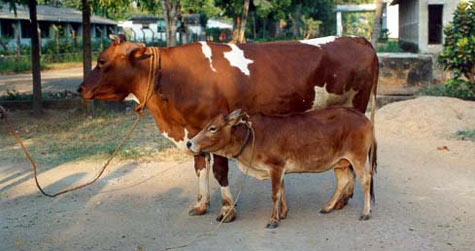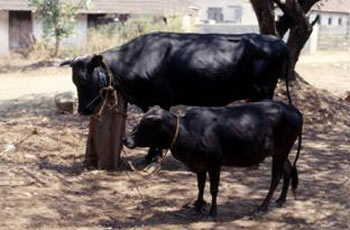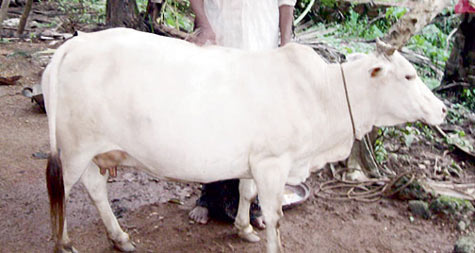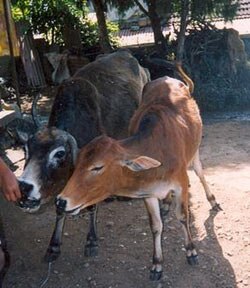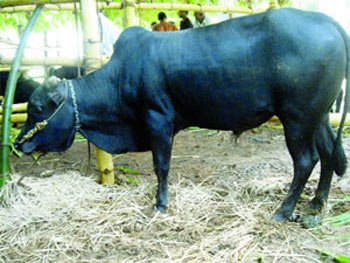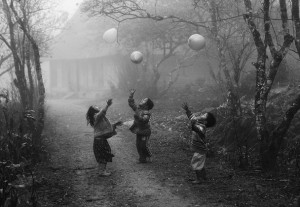കേരളത്തിലെ എന്നുവേണ്ട, ഭാരതത്തിലെത്തന്നെ നാട്ടാനകളുടെ നാളിതുവരെയുള്ള ചരിത്രത്തില് ഒരു അപൂര്വ്വ കഥാപാത്രമാ. ഗുരുവായൂര് കേശവന്റെ കഥ, ഏഷ്യയിലെ ഏറ്റവും വലിയ തേക്കുകള് വളരുന്ന നിലമ്പൂര് വനാന്തരഭാഗങ്ങളില് നിന്ന് ആരംഭിക്കുന്നു.
നിലമ്പൂര് കാട്ടിലെ വാരിക്കുഴിയിലാണ് കുട്ടിയായ കേശവന് വീണത്. ഐശ്വര്യം കത്തിനില്ക്കുന്ന നിലമ്പൂര് കോവിലകത്തിന്റെ മുറ്റത്ത്, കോവിലകം വക പന്ത്രണ്ടാമത്തെ ആനയായി കേശവന് വന്നു.
ആയിടയ്ക്കാണ്, മലബാറിലാകമാനം അസ്വാസ്ഥ്യങ്ങളുയര്ത്തിയ മാപ്പിള ലഹള പൊട്ടിപ്പുറപ്പെട്ടത്. ഗത്യന്തരമില്ലാതെ വന്നപ്പോള് നിലമ്പൂര് വലിയ രാജാവ് സകുടുംബം തൃശൂര്ക്ക് താമസം മാറ്റി. ആത്മരക്ഷാര്ത്ഥമുള്ള പലായനംതന്നെ. സ്വത്തുവഹകളും ആനകളേയും സംരക്ഷിക്കുന്ന ചുമതല കാര്യസ്ഥനായ ഒരു പണിക്കരെ ഏല്പ്പിച്ചു. അതുകൊണ്ട് പക്ഷേ ഫലമുണ്ടായില്ല. പണിക്കര് ലഹളയില് വധിയ്ക്കപ്പെട്ടു. വലിയതമ്പുരാന് പരിഭ്രാന്തനായി. ഇനി എന്തുചെയ്യും? സര്വ്വനാശത്തിന്റെ കരിനിഴലുകളാണ് കണ്മുന്നില്. അന്നൊരു ദിവസം, ആ ശുദ്ധഹൃദയന് ഉള്ളുരുകി പ്രാര്ത്ഥിച്ചു: "എന്റെ ഗുരുവായൂരപ്പാ, ആനകള് ഉള്പ്പെടെയുള്ള സ്വത്തുവഹകള് തിരിച്ചുകിട്ടിയാല് ഒരു ആനയെ ഗുരുവായൂരപ്പന് വഴിപാട് ചെയ്യാം...''
ആ പ്രാര്ത്ഥന ഫലിച്ചു. ഗുരുവായൂരപ്പന് അനുഗ്രഹിച്ചു. അങ്ങിനെയാണ് 1922 ജനുവരി നാലാം തീയ്യതി കേശവന് എന്ന കുട്ടിക്കൊമ്പന് ഗുരുവായൂര് ക്ഷേത്രത്തിലെത്തുന്നത്.
ഗുരുവായൂരപ്പന്റെ ഭക്തന്മാര്ക്കിടയില് 'അഷ്ടപദി തിരൂപ്പാട്' എന്ന പേരില് പരക്കെ അറിയപ്പെട്ടിരുന്ന പരേതനായ ഉണ്ണിരാരിച്ചന് തിരുമുല്പ്പാട്, കേശവന് എന്ന വികൃതിയെ വെള്ളയും കരിമ്പടയും വിരിച്ച് നിലമ്പൂര് തമ്പുരാന് നടയിരുത്തി കളഭം കഴിച്ച രംഗം നേരില് കണ്ട വ്യക്തിയാണ്. പില്ക്കാലത്ത് കേശവന്റെ ഒരു അടുത്ത ചങ്ങാതിയും ആരാധകനുമായി മാറിയ തിരുമുല്പ്പാട്, അന്നത്തെ രംഗം ഒരിക്കല് ഈ ലേഖകനോട് വിവരിക്കുകയുണ്ടായി:
'ദേ, അന്നത്തെ കേശവന് ഇത്രയേയുണ്ടായിരുന്നുള്ളു- നല്ലൊരു മൂരിക്കുട്ടിയുടെ വലിപ്പം.' തിരുമുല്പ്പാട് അംഗവിക്ഷേപങ്ങളോടെ തുടര്ന്നു: 'വിശേഷവിധിയായി ഒന്നുമില്ലാത്ത ഒരു കൊമ്പന്കുട്ടി, എന്നാല് മുഖത്തിനൊരു ശ്രീത്വമുണ്ടായിരുന്നു, കൊമ്പിനു ഭംഗിയും...'
ആകാരഗാംഭീര്യംകൊണ്ടും ആകെപ്പാടെയുള്ള ആനച്ചന്തംകൊണ്ടും അതുല്യനായ ഗുരുവായൂര് പത്മനാഭന് (ഗുരുവായൂര് കേശവന്റെയും കാരണവര്) അക്ഷരാര്ത്ഥത്തില് അരങ്ങുഭരിയ്ക്കുന്ന കാലഘട്ടത്തിലാണ് കേശവന് വന്നത്. പില്ക്കാലത്ത് പക്ഷേ, കേശവന്റെ പേരും പെരുമയും പത്മനാഭന്റേതിനേക്കാള് പതിന്മടങ്ങു വളര്ന്നു.
വന്നകാലത്ത് മിക്കവാറും സമയം കേശവന് ക്ഷേത്രത്തില്ത്തന്നെയായിരുന്നു. രണ്ടുനേരവും ശീവേലിയും എഴുന്നള്ളിപ്പും. (അക്കാലത്ത് അത്താഴശ്ശീവേലിയ്ക്ക് ആനയുണ്ടായിരുന്നില്ല.) തിടമ്പ് ശിരസ്സില് വെച്ചാല് തല ആവുന്നത്ര ഉയര്ത്തിപ്പിടിക്കാന് പാപ്പാന്മാര് നിര്ബന്ധിക്കും. പിന്നീടതൊരു പതിവായി. തിടമ്പ് അല്ലെങ്കില് കോലം തലയില്വെച്ചാല് പിന്നെ കേശവന്റെ തല ആവുന്നത്ര ഉയരും. പില്ക്കാലത്ത് ഏതു കൊലകൊമ്പന്മാരുടെ നടുക്കും ഏറ്റവും വലിയ, ഏറ്റവും അധികം തലയെടുപ്പുള്ള പ്രമാണക്കാരനായി കേശവന് നിലനില്ക്കാന് സാധിച്ചതിന്റെ ബാലപാഠം അങ്യസിച്ചതിങ്ങനെയാണ്. പിന്നെ അതൊരു നിത്യശീലമായി; മാത്രമല്ല, ആ തലയെടുപ്പ് എഴുന്നള്ളിപ്പിലെ ഒരു കലയായി കേശവന് വളര്ത്തിയെടുക്കുകയും ചെയ്തു. കോലം തലയില്വെച്ചാല്, കേശവന് ഇടത്തും വലത്തും നില്ക്കുന്ന പറ്റാനകളെ ഒന്നു നോക്കും. പിന്നെ, ഒരു തലയുയര്ത്തലാണ്! ആ ഉയര്ന്ന നില്പ് എത്ര മണിക്കൂര് വേണമെങ്കിലും ആവാം. ആ തല പിന്നെ അല്പം താഴണമെങ്കില് കോലം ഇറക്കണം.
പ്രായപൂര്ത്തിയായപ്പോള്, കേശവന് ഒരു ഓമനപ്പേര്(അതോ ചീത്തപ്പേരോ?) വീണു. ഭ്രാന്തന് കേശവന്! ഇടക്കിടെ മദം ഇളകിയിരുന്നവെന്നതാണിതിനുകാരണം. കേശവന് മദമിളകുക എന്നു പറഞ്ഞാല്, അത് കേവലം മദപ്പാടിലാവുകയൊന്നുമല്ല. ശരിക്കും ഇളക്കംതന്നെ. തനി നട്ടുച്ചഭ്രാന്ത്. പിന്നെ ഇന്നതേ കാട്ടിക്കൂട്ടൂ എന്നില്ല. അങ്ങനെയാണ് 'ഭ്രാന്തന് കേശവന്' ആയത്.
ഈ ഭ്രാന്തു മാറാനായി പല ചികിത്സകളും ചെയ്തു. ഫലിച്ചില്ല. പിന്നീട് ഗുരുവായൂര് ക്ഷേത്രത്തില്ത്തന്നെ നാല്പ്പത്തൊന്നു ദിവസം ഭജനം നടത്തി എല്ലാ ദിവസവും നെയ്യ് ജപിച്ചുകൊടുത്തു. ഏതായാലും അതോടെ ഭ്രാന്ത് മാറി.
ഒരു അപകടമരണത്തെത്തുടര്ന്ന് അന്നത്തെ ഗജരത്നം പത്മനാഭന് അരങ്ങൊഴിഞ്ഞപ്പോള് ആ സ്ഥാലത്ത് കേശവന് അവരോധിക്കപ്പെട്ടു. ആ പദവിയുടെ പ്രാധാന്യവും ഗാംഭീര്യവും ഗൌരവവും കേശവന് ശരിയ്ക്കും മനസ്സിലാക്കി. ഒന്നുരണ്ടുകൊല്ലത്തിനകം, കേരളത്തിലങ്ങോളമിങ്ങോളമുള്ള ഏത് എഴുന്നള്ളിപ്പിലും ഒന്നാമന് കേശവനായി.
കേശവന് ഇങ്ങോട്ടും കേശവനെ അങ്ങോട്ടും അതിരറ്റ് സ്നേഹിക്കുകയും ഭയപ്പെടുകയും ചെയ്തിരുന്ന രണ്ടു വിദഗ്ധ പാപ്പാന്മാരായിരുന്നു മാണിനായരും, ചെറിയ അച്യതന്നായരും. ഏതാണ്ട് കേശവന്റെ അത്ര തലയെടുപ്പോടെ, നെഞ്ചുവിരിച്ച്, കൊമ്പുപിടിച്ച് എഴുന്നള്ളിപ്പിന് നിന്നിരുന്ന കരുത്തനായ മാണിനായരുടെ ചിത്രം ഇന്നും ഓര്മ്മയിലുണ്ട്. ചെറിയ അച്യുതന്നായര്ക്ക് തണ്ടും തടിയും കുറവായിരുന്നു. പക്ഷെ, നാല്പതുകൊല്ലക്കാലം കേശവനെ സ്വന്തം മകനെയെന്നപോലെ ശുശ്രൂഷിച്ച അച്യുതന്നായരും കേശവനും തമ്മിലുള്ള ബന്ധവിശേഷം വിവരിക്കാനാവില്ല. 'മോനേ, കേശവന്കുട്ട്യേ' എന്നല്ലാതെ അച്യുതന്നായര് വിളിക്കാറില്ല. ആ വിളികേട്ടാല്, കേശവന് തലതാഴ്ത്തും; അപ്പോള് അച്യുതന്നായര് കേശവന്റെ കീഴ്ത്താടി പിടിച്ച് ചൊറിയുകയും കുശലപ്രശ്നം നടത്തുകയും ചെയ്യും. എല്ലാംകേട്ട്, വലിയ സന്തോഷമായി എന്ന അര്ത്ഥത്തില് കേശവന് തലയാട്ടും, ചില ശബ്ദങ്ങള് പുറപ്പെടുവിക്കും!
അച്യുതന്നായര് കേശവനെ അങ്ങിനെ അടിയ്ക്കാറില്ല. എന്നാല് ഇടതുകൈകൊണ്ടൊരു പൂശ് പൂശിയാല് അത്രവേഗം മറക്കാനും പറ്റില്ല. അടിച്ചാലുടന് അച്യുതന് നായര്ക്ക് സങ്കടമാവും. പിന്നെ തുമ്പിക്കൈ കെട്ടിപ്പിടിയ്ക്കും, കരയും. മുന്കാലുകള് തലോടിയും 'സാരമില്ലെടാ മോനേ...' തുടങ്ങിയ ആശ്വാസവചനങ്ങള്. അതുകേട്ടാല് കേശവനു സങ്കടമാവും.
മാണിനായരെ കേശവന് ശരിയ്ക്കും ഭയമായിരുന്നു. ആ മരക്കോലുകൊണ്ട് ഒന്നു തോണ്ടിയാല് മതി, ഏതു ആനയും മൂത്രമൊഴിച്ചുപോകും.
സ്വഭാവത്തില് കേശവന് പല സവിശേഷതകളുമുണ്ടായിരുന്നു. തിടമ്പ് എഴുന്നള്ളിക്കാന് മാത്രമേമുന്കാലുകള് മടക്കുകയുള്ളു. ക്ഷേത്രത്തിനകത്തായാലും പുറത്തായാലും പാപ്പാന് പുറത്തുകയറി ഇരിക്കുന്നത് ഇഷ്ടമല്ല. അടി സഹിക്കും, എന്നാല് ശകാരം സഹിക്കില്ല. ഏതു ഉത്സവത്തിനു ചെന്നാലും കോലം തന്റെ ശിരസ്സില്ത്തന്നെ വേണം.
ഒരിക്കല്, ചെറിയ അച്യുതന് നായര് ഈ ലേഖകനോട് പറഞ്ഞ ഒരു കഥ ഓര്മ്മ വരുന്നു: കൊടുങ്ങല്ലൂരിനടുത്ത തിരുവഞ്ചിക്കുളം ക്ഷേത്രത്തിലെ ഉത്സവം. കേശവനും വേറെ ആനകളുമുണ്ട്. പ്രമാണി കേശവന്തന്നെ. ഒരുദിവസം, കേശവനേക്കാള് ഉയരമുള്ള ഒരു ആന വന്നു. സ്വാഭാവികമായും തിടമ്പ് ഏത് ആനയുടെ പുറത്ത് എഴുന്നള്ളിക്കണം എന്നതൊരു തര്ക്കവിഷയമായി. നാട്ടുകാര് രണ്ടു ചേരിയായി. അവസാനം ഒത്തുതീര്പ്പ് ഫോര്മുല വന്നു. നെറ്റിപ്പട്ടം കെട്ടാതെ, രണ്ട് ആനകളേയും അടുത്തടുത്തു നിര്ത്തി ഉയരം അളക്കുക. കൂടുതല് ഉയരമുള്ള ആനയുടെ പുറത്ത് തിടമ്പ് എഴുന്നള്ളിക്കാം.
അതനുസരിച്ച് കേശവനേയും എതിരാളിയേയും അടുത്തടുത്തു നിര്ത്തിനോക്കിയപ്പോള് അച്യുതന്നായരും അന്തംവിട്ടു; മറ്റേ ആനയ്ക്ക് കേശവനേക്കാള് അല്പം ഉയരംകൂടും! അച്യുതന് നായര് ആ രംഗം വര്ണ്ണിക്കുന്നു:
"എന്നിട്ടും ഞങ്ങള് വിട്ടുകൊടുത്തില്ല. കോലം വച്ച് ഉയരം നോക്കണം എന്ന് ശഠിച്ചു. എല്ലാവരും സമ്മതിച്ചു. ഉടനെ രണ്ടുകോലം കൊണ്ടുവന്നു. കേശവന്റെ ശിരസ്സില് കോലം കയറ്റിയപ്പോള്, ഞാന് എന്റെ മോന്റെ മുഖത്തുനോക്കി, നെഞ്ചത്തടിച്ച് കരഞ്ഞുപറഞ്ഞു: "മോനേ, ചതിക്കൊല്ലെടാ കേശവന്കുട്ട്യേ...!'' അതു കേള്ക്കേണ്ട താമസം അതാ ഉയരുന്നു കേശവന്റെ ശിരസ്സ്, ആകാശത്തോളം. മറ്റെ ആനയുടെ തല പിന്നെ പൊന്തിയിട്ടില്ല.'' അത്രയും പറഞ്ഞപ്പോഴേക്കും അച്യുതന് നായരുടെ കണ്ണുനിറഞ്ഞു; ശബ്ദം ഇടറി.
ഇണങ്ങിയാലും പിണങ്ങിയാലും കേശവന്റെ ചിട്ടയും ചടങ്ങും ബഹുകേമമാണ്. അനാവശ്യമായി പണിയെടുക്കുന്നത് കേശവന്റെ ഇഷ്ടമല്ല.(ആവശ്യത്തിന് എത്ര വേണമെങ്കിലും അധ്വാനിക്കും. ഇപ്പോഴത്തെ കൊടിമരത്തിനുള്ള പടുകൂറ്റന് മരം ചാവക്കാടുനിന്ന് കേശവന് ഒറ്റയ്ക്കാണ് വലിച്ചുകൊണ്ടുവന്നത്.) മദം ഇളകിയാലും ആരേയും ഉപദ്രവിക്കില്ല. ആരേയും കൊന്നിട്ടുമില്ല.
"ലക്ഷണപ്രകാരം കേശവന് ബ്രാഹ്മണകുലജാതനാണ്.'' കേശവനെ അടുത്തറിയാവുന്ന വ്യക്തിയും മാതംഗലീല എന്ന ശാസ്ത്രഗ്രന്ഥം കമ്പോടുകമ്പ് തോന്നുന്ന സര്വ്വകലാവല്ലഭനായ പൂമുള്ളി നീലകണ്ഠന് നമ്പൂതിരിപ്പാട് ഒരിക്കല് പറഞ്ഞു; 'അതുകൊണ്ട് ആവന് ആരേയും കൊല്ലാതിരുന്നത്. സാധുവായ പ്രകൃതം- മുന്ശുണ്ഠിയുണ്ടാവാം...'
ഗുരുവായൂരില് നിന്ന് എത്ര അകലെ ഏതു എഴുന്നള്ളിപ്പിനു പോയാലും, തനിക്കുവേണ്ട എന്നു തോന്നിയാല് ആ നിമിഷം കേശവന് ഗുരുവായൂര്ക്ക് സ്വന്തം ഇഷ്ടപ്രകാരം തിരിച്ചുനടക്കും. ആരു തടഞ്ഞിട്ടും കാര്യമില്ല. ഒരിക്കല് തൃശൂരിനടുത്ത് കൂര്ക്കഞ്ചേരി ക്ഷേത്രത്തില് പൂയം എഴുന്നള്ളിപ്പിന് കൊണ്ടുപോവുകയായിരുന്നു. പുഴയ്ക്കല് എന്ന സ്ഥലത്തെത്തിയപ്പോള് കേശവനു തോന്നി, മതി, ഗുരുവായൂര്ക്ക് മടങ്ങാം എന്ന്. പിന്നെ താമസമുണ്ടായില്ല, തിരിഞ്ഞൊരു നടത്തം! സമയം രാത്രി. എതിരെ വന്ന ബസുകള്ക്കും കാറുകള്ക്കും ലോറികള്ക്കും മറ്റും ക്ളീനായി സൈഡ് കൊടുത്ത് മെയിന്റോഡിലൂടെ രാജകീയമായ തിരിച്ചെഴുന്നള്ളത്ത്! ആനക്കാരും ആള്ക്കൂട്ടവും പിന്നില്. പുലര്ച്ചയ്ക്ക് കേശവന് ഗുരുവായൂരിലെത്തി. നേരെ ക്ഷേത്രത്തിനകത്തു കടന്ന് വടക്കുഭാഗത്ത് അടങ്ങിയൊതുങ്ങി നിന്നു. വിശേഷിച്ചൊന്നും സംഭവിക്കാത്തതുപോലെ.
അനിതരസാധാരണമായ തലയെടുപ്പുകാരണം ഉത്സവക്കമ്മിറ്റിക്കാര് കേശവനെ കിട്ടാന് അക്കാലത്ത് വാശിയോടെ മത്സരിച്ചുകൊണ്ടിരുന്നു. എത്ര വലിയ സംഖ്യ ഏക്കം കൊടുക്കാനും അവര് തയ്യാറായി. ഈ മത്സരമനോഭാവം തൃശൂര്പൂരത്തിലെ പ്രധാനവിഭാഗങ്ങളായ തിരുവമ്പാടി, പാറമേക്കാവ് ദേവസ്വക്കാരിലും വല്ലാത്ത വാശിയായി വളര്ന്നു. പിന്നീട് എം.കെ. രാജാ ദേവസ്വം മാനേജരായി വന്നപ്പോഴാണ് അസുഖകരമായ ഈ മത്സരം ഒഴിവാക്കിയതും കേശവനെ ഓരോ വര്ഷവും ഓരോ വിഭാഗത്തിന് നല്കാം എന്ന വ്യവസ്ഥയുണ്ടാക്കിയതും.
അത്യപൂര്വ്വമായ ഒരു പട്ടത്താനത്തിന്റെ കഥ കൂടി പരയാതിരിക്കാന് വയ്യ. ഗുരുവായൂര് ക്ഷേത്രത്തില് കേശവന് അരനൂറ്റാണ്ടുകാലത്തെ സേവനം പൂര്ത്തിയാക്കിയതിന്റെ ഓര്മ്മയ്ക്ക് 'ഗജരാജപട്ടം' സമ്മാനിച്ച ആ സംഭവം. 1973ല്. കേശവന്റെ അറുപതാം പിറന്നാളാഘോഷവും അന്നായിരുന്നു. ആനത്തറവാടുകളില് ഇന്നുവരെ ഒരു കാരണവര്ക്കും കിട്ടിയിട്ടില്ലാത്ത സ്നേഹാദരങ്ങള്, അനുമോദനഘോഷയാത്ര, അകമ്പടി വാദ്യമേളങ്ങള്, ആനസദ്യ, അവാര്ഡ്ദാനം...
അനന്തരാവകാശികളായ ഇരുപതിലേറെ ആനകളുടേയും വാദ്യമേളങ്ങളുടേയും ആവേശംകൊണ്ട് തുള്ളിച്ചാടുന്ന ആരാധകരുടേയും അകമ്പടിയേടെ കേശവന്, ഗാംഭീര്യമേതും വിടാതെ കിഴക്കെ നടയിലെ ദീപസ്തംഭത്തിനടുത്തെത്തി നിന്ന രംഗം ഇപ്പോഴും എന്റെ കണ്മുന്നിലുണ്ട്. സ്നേഹവാത്സല്യങ്ങളുടെ ആധിക്യത്തില് ആണ്ടുമുങ്ങിയ ജനക്കൂട്ടം, കേശവന് ഒരു ആനയാണെന്ന പരമാര്ത്ഥംപോലും മറന്നതുപോലെയാണ് പെരുമാറിയത്. ചിലര് കേശവന്റെ തുമ്പിക്കൈ കെട്ടിപ്പിടിച്ച് സന്തോഷം സഹിക്കാതെ പൊട്ടിക്കരഞ്ഞു. ചിലര് ഭയാശങ്കയില്ലാതെ കൊമ്പിന്മേല് മാലകള് ചാര്ത്തി. അവിലും മലരും പഴവും ശര്ക്കരയും നാളികേരവും കുന്നുകൂട്ടി. എല്ലാംകണ്ടും കേട്ടും രസിച്ച്, ചെവിയാട്ടി കേശവന് നിന്നു- ഇന്ന് നിങ്ങളുടെ ദിവസമാണ്, ഞാന് നിന്നുതരുന്നു എന്ന മട്ടില്.
ജ്വലിച്ചുനിന്ന ആവേശത്തിരയിളക്കത്തിനിടയില്, കേശവനെ ഗജരാജപട്ടം ചാര്ത്തിയപ്പോള് കിഴക്കെ ഗോപുരനട ആഹ്ളാദപ്രകടനങ്ങളാല് അക്ഷരാര്ത്ഥത്തില് പൊട്ടിത്തെറിച്ചു! ആ ഗജരാജപട്ടം ചാര്ത്തി, നടയില് കയറി നിന്ന്, ശ്രീലകത്തേക്ക് നോക്കി, കേശവന് മൂന്നുവട്ടം തൊഴുതു. അപ്പോള് പുറത്തുനില്ക്കുന്ന കേശവന്റേയും അകത്തുള്ള കേശവനുണ്ണിയുടേയും മിഴികള് നിറഞ്ഞിട്ടുണ്ടാവില്ലേ?
ഇനി, അഭിനവ ഗജേന്ദ്രമോക്ഷം. 1976 ഏകാദശി മഹോത്സവത്തിന്റെ ഭാഗമായി ക്ഷേത്രത്തില് വിളക്ക് പൊടിപൊടിച്ചു നടക്കുന്ന നവമിരാത്രി. എങ്ങും നെയ്വിളക്കിന്റെ പ്രഭാപൂരം.
വിളക്കിനെഴുന്നള്ളിച്ചു. കര്പ്പൂരനാളങ്ങള് പ്രദക്ഷിണവഴിയില് വിടര്ന്നു. അഷ്ടഗന്ധം പുകഞ്ഞു. ചന്ദനത്തിരികള് പരിമളം പൊഴിച്ചു. ഇടക്കവാദ്യത്തിന്റെ ലയത്തില് നാഗസ്വരമുയര്ന്നു. സ്വര്ണ്ണക്കോലം ശരസ്സിലേന്തിയ ഗജരാജന് കേശവന് പതിവുപോലെ നടുക്കു തലയുയര്ത്തിനിന്നു.
പെട്ടെന്നാണ് പലരും കണ്ടത്: കേശവന് അതാ കിടുകിടാ വിറയ്ക്കുന്നു. ശരീരം കുഴയുന്നു...
എങ്ങും പരിഭ്രമം, ഉത്കണ്ഠ, ആശങ്കകള്... വളരെ പെട്ടെന്ന് കോലം ഇറക്കി.
കേശവനെ പതുക്കെ നടത്തി തെക്കെ നടയിലെ കോവിലകംപറമ്പിലെത്തിച്ചു. അന്ന് വേച്ചുവേച്ച് കേശവന് കിഴക്കെ ഗോപുരം കടന്നു പുറത്തുപോയപ്പോള് അത് അവസാനത്തെ യാത്രയുടെ തുടക്കമായിരുന്നുവെന്ന് ആരും കരുതിയിരിക്കാനിടയില്ല.
പിറ്റെദിവസം ദശമി. ഗുരുവായൂരും പരിസരവും ഏകാദശി ഉത്സവത്തിന്റെ വെളിച്ചത്തില് കുളിച്ചുനില്ക്കുമ്പോഴും, എവിടേയും ഒരു ഗദ്ഗദം; കേശവന് അസുഖം ഏറിവരുന്നു!
വിദഗ്ധ ചികിത്സകള് പലതും ചെയ്തു. കേശവന് തിന്നാതെ, കുടിയ്ക്കാതെ, അനങ്ങാതെ, ഒരേനില്പ്പ്. ക്ഷേത്രം നോക്കി, സ്വര്ണ്ണക്കൊടിമരം നോക്കി നിറമിഴികളോടെ ഒരേ നില്പ്പ്!
രാത്രിയായി, ദശമിവിളക്ക് അത്യാര്ഭാടത്തോടെ സമാപിച്ചു. നേരം പുലരുന്നു. ഏകാദശിദിവസം. അര്ജ്ജുനന് ഭഗവാന്റെ വിശ്വരൂപം ദര്ശിച്ച ദിവസം. സാക്ഷാല് മേല്പ്പത്തൂര് ഭട്ടതിരിപ്പാട്, ഭഗവാനെ കണ്മുന്നില് കണ്ട്, കണ്ഠമിടറി 'അഗ്രേപശ്യാമി' എന്ന് പാടിയ ദിവസം.
ബ്രാഹ്മമുഹൂര്ത്തം. കുളിരിളം കാറുപോലെ ഉച്ചഭാഷിണിയിലൂടെ, നാരായണീയം ഒഴുകിവന്നു. അപ്പോഴാണ് ഇടിത്തീ വന്നുവീണതുപോലെ ആ നടുക്കുന്ന വാര്ത്ത കേട്ടത്. "കേശവന്.. നമ്മുടെ കേശവന്... പോയി... കേശവന് മരിച്ചു...''
അതെ, കേശവന് ചെരിഞ്ഞു .........



